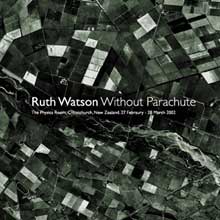 |
|||||||||
|
|
| ...GALLERY EXHIBITS 2002 | ...FROM THE AIR | |||||||||
|
From the Air: Ruth Watson, 'Without Parachute', at the Physics Room Jonathon Smart Ruth Watson's practice might not be a lingua franca, but it is certainly a lingua geographica. For almost twenty years her work has been informed by maps of many kinds, a sometimes multi-media interrogation of the politics, passions and issues of representation that have arisen out of our evolving claims and ownership of land. Maps offer visual testament to such "ownership". Variously projected, constructed, and pushed and pulled by vested interest - maps have been at the core of Watson's oeuvre. Here "without parachute", interestingly she is also without map. Instead, she has used cartography's kissing cousin, the aerial photograph, to form the basis of this show. The Wigram air base in Christchurch was the originating site of the first aerial surveys of New Zealand - visual records of the patterned geometries of field and road, from mountain to the sea. Such patterns might be the envy of many an abstractionist, or today's fashionista; but here they are silken and made into a dress recalling the era in which one of Watson's forebears made a one-way journey to a foreign land. Patterns and dress then, are both foreign and familiar; known, yet strange together. Tiny houses of the city sit alongside eroded hills, man made structures alongside snow patterns: all ruched, folded, sewn together into a graceful and somewhat fragile whole. Past and present combined. These aerial composites collaged into the Victorian and the work-a-day, suggest something viewed from a distance, then patchworked together like the Canterbury plains. Ruth's sense of fabrication, her process of making, becomes integral to the conceptual nature of her project. Which is typical. It is typical of Watson's ability to inflect the post-colonial with a visual construct both wilfully cross-disciplined and resolutely informed. Or is it that lingua geographica, this particular artist's geographic tongue, is simply wagging in a more determined, idiosyncratic or fissured way than normal? Watson has lived and made art in New Zealand, Germany and Australia. In this exhibition she is "without parachute", landing again in Christchurch - a place Victorian in conception (for which she has dressed appropriately) - a place with which she has a quite particular relationship, framed both by the benefits of distance and the intimacy of birth. Her interrogation of the (mostly Cantabrian) land forms here, remind me of T.S. Eliot's lines: "And the end of all our exploring/ Will be to arrive where we started/ And know the place for the first time". Watson's form of knowing is to imply that the picture is created from a variety of sources, and while stitched together to form a whole, might still be subject to a little stress: threads hang outwards, seams are visible. Only the exploration seems certain. From the Catalogue Without Parachute |
|||||||||
